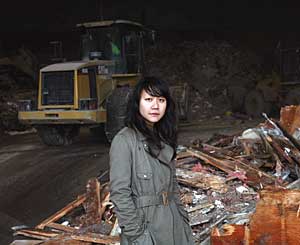It wasn’t a good year for the Paul Rudolph Foundation. In 2004, Ernst Wagner, who established the foundation, took a nasty fall in the Manhattan town house that Rudolph designed for himself and Wagner in 1989. His injury followed the departure of the foundation’s director, who left due to a budget shortfall.

Wagner and the foundation recovered, but today the organization faces a new crisis as Rudolph’s buildings are endangered by a storm of real estate pressure and Rudolph’s association with the misunderstood and underappreciated Brutalist movement. The list of threatened or demolished structures includes a 1972 house commissioned by Dr. and Mrs. Louis Michaels in Westport, Connecticut, that came down in January. The current owners of Rudolph’s Cerrito residence in Watch Hill, Rhode Island, were making plans to tear down that property until, earlier this month, a pair of New Yorkers stepped in with an offer to move it to the Catskills.
Sarasota, Florida, where Rudolph was a leader of the city’s namesake school of Modernist architecture, is the most active battleground for his legacy. The grassroots group Save Riverview, working with the National Trust for Historic Preservation, recently won a stay of execution for Riverview High School, which the county wanted to demolish; they have until March 2008 to raise $20 million for an alternative scheme to move forward. Also in Sarasota, Joe King, AIA, a published Rudolph expert, recently applied to demolish the Twitchell House after deciding it financially imprudent to restore the 1941-vintage residence. In addition to needing repairs after a fire and flooding, the structure sits just 25 feet from the Gulf of Mexico, making it a candidate for repeat damage. King has tentatively worked out a deal to rebuild the house elsewhere.
The Paul Rudolph Foundation is following new plans to fight these threats, thanks to Nepal Asatthawasi, who was named coordinator of the organization last October. The 26-year-old understands that some observers will do a double-take at her age, but she wants to use her generation’s savvy to build excitement about Rudolph’s work. “I’m perhaps more open to technological intervention,” she says, and discusses transforming the foundation’s Web site into a dynamic networking site that offers “news of teardowns and rumors of a teardown, not just of Rudolph buildings but his whole generation’s.”
Asatthawasi’s expanded vision for the foundation includes educational efforts founded on wiki culture as well as elbow grease. She is currently documenting Rudolph’s houses and will make this archive available online; a film is also in the works. To help boost the foundation’s meager revenue, Asatthawasi is inviting more members to join its board—and telling candidates that fund-raising will be a responsibility of membership. Although it won’t increase revenue, she also plans to get Rudolph homeowners “involved in an exclusive network. And hopefully they’ll appreciate it enough to pass on those values, and perhaps not be so quick to pass on the property to a less sensitive buyer.” She is introducing sellers to interested buyers, or encouraging them to use auction houses instead of local property brokers.
Asatthawasi admits that the foundation is unable to purchase properties outright, but she compares her job to leading a high-tech startup company and suggests that the foundation’s online endeavors could help reignite the field of preservation. “I haven’t seen any kind of widespread effort to do something vital in this realm,” she notes.



Post a comment to this article
Report Abusive Comment